The Watchers
 for violence, terror and some thematic elements.
for violence, terror and some thematic elements.
Reviewed by: Keith Rowe
CONTRIBUTOR
| Moral Rating: | Very Offensive |
| Moviemaking Quality: |
|
| Primary Audience: | Adults Young-Adults Teens |
| Genre: | Supernatural-Horror Mystery Adaptation |
| Length: | 1 hr. 42 min. |
| Year of Release: | 2024 |
| USA Release: |
June 7, 2024 |
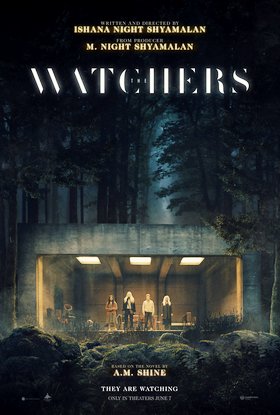

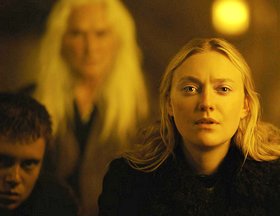
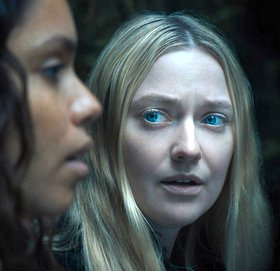

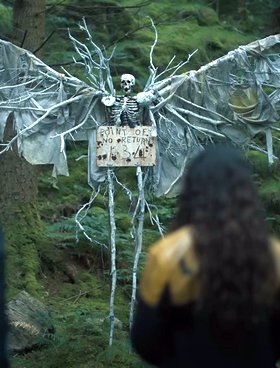
Film based on the novel by A.M. Shine, author of Literary Horror from the west of Ireland
Setting: Irish horror set in a mysterious forest in western Ireland not charted on any map
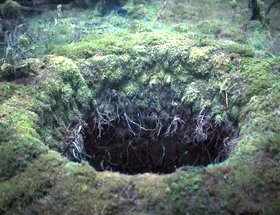
Unseen underground supernatural creatures
Trapped along with three strangers
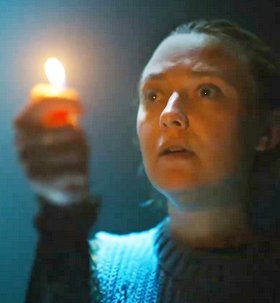
Overcoming FEAR, Anxiety and Worry—What does the Bible say? Answer

FILM VIOLENCE—How does viewing violence in movies affect families? Answer
Learn about spiritual darkness
| Featuring |
|---|
|
Dakota Fanning … Mina Georgina Campbell … Ciara Olwen Fouéré (Olwen Fouere) … Madeline Siobhan Hewlett … Mina’s Mother Hannah Howland … Chloe See all » |
| Director |
|
Ishana Shyamalan, daughter of M. Night Shyamalan |
| Producer |
|
Blinding Edge Pictures Inimitable Pictures See all » |
| Distributor |
“They are watching”
Mina (Dakota Fanning) is a bored pet store employee who prefers vaping and doodling in her sketchbook to doing actual work. Her boss asks her to deliver a golden parakeet to a nearby town in Ireland. She reluctantly agrees, probably because she figures a drive through the country would be preferable to staring at lizards and snakes all day. Most people would question their directions when finding themselves on a single-track dirt road in the middle of a dense forest, but not Mina.
When her car dies, Mina strolls into the forest to find help, but immediately gets lost. As night approaches, she encounters Madeline (Olwen Fouéré), an old woman who tells her to get inside a concrete bunker before vicious creatures (Watchers) come out to hunt. Once safely inside the large rectangular room, Mina meets the other survivors, Ciara (Georgina Campbell) and Daniel (Oliver Finnegan). They mindlessly chant the rules as if in a trance: don’t turn your back on the mirror, don’t open the door after dark, don’t go near the burrows (giant holes in the ground), etc.
During the day, the four survivors go outside to hunt for small game, collect medicinal herbs and venture out as far as they dare in every direction to make a map of the region… but they must always return by sundown. One night, there’s a banging at the door. It’s Ciara’s husband John (Alistair Brammer), who’s been missing for several days. His urgent cries for help are soon drowned out by the shrieking howls of the rapidly approaching Watchers.
Should they risk letting him in?
This is just one of several really good suspense scenes in this lost-in-the-woods thriller.
“The Watchers,” which marks the directorial debut of Ishana Shyamalan, daughter of M. Night Shyamalan (“The Sixth Sense”). Ishana also wrote the script, which is based on the book of the same name by A.M. Shine.
The movie starts out well with an intriguing mystery, restrictive rules and compelling iconography (especially the “Point of no return” signs), all set in an immersive, eerie environment. Unfortunately, the story fails to capitalize on its strong premise by relying too heavily on horror movie gimmicks, which really aren’t that scary.
In addition to mimicking other horror films, “The Watchers” infuses a heavy quotation of “The Time Machine” (1960) into its narrative. In that film, based on H.G. Wells’ seminal sci-fi tale, the surface-dwelling Eloi must retreat indoors before dark or risk being eaten by the cave-dwelling Morlocks. In “The Watchers,” the titular creatures live deep underground but access the surface through large burrows in the ground. Similarly, in “The Time Machine,” characters access Morlock caves by entering cone-like openings on the surface and climbing down a long ladder. Not exactly the same, but close enough for the sake of comparison.
The whole bit with delivering the bird, the scenes where flocks of birds fly overhead, and the action beat where a bird dive-bombs one of Mina’s friends, are all reminiscent of the gags used in Alfred Hitchcock’s “The Birds.” Also, there’s an allusion to the hatch in “Lost,” but I’m not going down that rabbit hole.
To its detriment, the movie is riddled with nitpicks and plot holes. Spoilers: For instance, what happens to all the cars left behind by those who get lost in the woods? Does the forest just swallow them up (that seems to be the case with Mina’s car)? Also, during their many months spent in confinement, no one thought to look under the rug, and it’s only when the Watchers are banging down the door that they discover the hatch? C’mon! And would you really trust a pet store parakeet to guide you through the woods to a lake? Grade A ridiculousness.
And then there’s the most egregious plot blunder; Madeline should’ve insisted on being the one to collect the documents from the professor’s office, since she previously had a relationship with him. Though Mina learning about the halflings helps keep the audience up to speed, it reveals the truth the halflings have kept secret for centuries. Shoddy plotting.
Another downside is that the third act keeps stringing us along but never delivers the “Aha!” moment we’ve been anticipating since the start of the film. Perhaps Ishana was leery of employing a climactic twist since that story device proved to be such a fickle feature of her father’s films. Probably a wise choice, since a poorly-executed surprise ending could’ve tanked an already middling movie.
On the plus side, Ishana makes the most of her locations; the film was shot entirely in Ireland. It isn’t much of a stretch to say the creepy forest serves as an additional character in the film. In a very real sense, the hair-raising atmosphere is more dynamic than many of the characters, which have all the charm of the terrified trees that shiver each time a Watcher crawls past them in the dead of night.
But enough about the movie’s production elements.
Let’s take a look at the film’s…
Socio-Political Aspects
Before I saw “The Watchers,” I jotted down some general thoughts about the movie’s most striking image: four people trapped inside a glass-walled room surrounded by a foreboding forest at night.
Symbolically, the image may tap into our…
Fear of the surveillance state. Pervasive paranoia from always being watched. The government listening in on our phone conversations—the Patriot Act, TVs “Person of Interest.”
Fear of the weaponization of governmental agencies. People jailed over the January 6th “riot,” some of whom weren’t even in D.C. that day. The IRS targeting conservative groups (Lois Lerner). FBI targeting parents at school board meetings and labeling them as “domestic terrorists.” FBI targeting “radical-traditionalist” Catholics.
Fear of the loss of privacy. Identity theft. Prevalence of social media…everything we post is searchable. We can be canceled for what we say/believe. This may make us feel like we’re living in a glass house…like animals in a zoo.
Fear of another lockdown. People trapped inside their homes. Loss of the freedom to go about their normal daily lives. Physically shut off from other people.
Q & A
Overcoming FEAR, Anxiety and Worry—What does the Bible say? Answer
Of all the potential plot points listed above, the movie only addresses the “animals in a zoo” element (one character thinks the whole thing is a test, that the Watchers are observing them to see “what can drive a person mad”). It’s a shame that the movie chooses hokey pseudo-mythology over cultural relevance; signs and symbols (the obvious link between the bird in the cage and the four people inside the bunker) over substance. Any meaning derived from the movie is done so by accident rather than by design (i.e., is Mina’s apartment number “2B”—as in “to be or not to be”—a knowing nod at her existential crisis, or am I way ahead of the director… or just plain off my rocker?).
The movie does pose an interesting, unspoken question though, “Who watches the Watchers?” The answer is: the audience. We’re watching the Watchers watch their captives. This fascinating meta perspective underscores the notion that all film spectatorship is voyeuristic by nature. Hitchcock explored this theme from various angles in such movies as “Psycho,” “Vertigo” and “Rear Window.” I suppose if Ishana had to borrow from someone it might as well have been from the best (sorry pops).
In another meta level subplot, Mina and the others watch old episodes of a reality series called “Lair of Love” (a made-up series in the mold of “Big Brother”). “Lair” follows a dozen people around an isolated house and focuses on their frequent romantic escapades. Unlike the TV show, there are only four people shut into the bunker in the movie, and, fortunately, none of them fall in love with each other.
Spiritual Aspects
Other than an oppressive feeling of evil in the film, there really aren’t many spiritual elements to consider here. There are plenty of depictions of evil in the movie, like the winged skeleton made out of bones and sticks that sits atop a warning sign and the drawings/paintings of shadowy or tall, pale creatures in books or wall paintings in a professor’s office. The physical manifestations of evil in the movie are the Watchers themselves, which come in different shapes, sizes and temperaments (indeed, the movie never properly classifies the mythical beings, referring to them as fairies, changelings, winged people, and halflings—send royalty checks to the Shire, Middle Earth).
Halflings are the result of a Watcher mating with a human. According to the movie, in the distant past Watchers and humans lived in harmony, some more so than others it would seem. Sounds kind of out there, but would you believe a similar case—spiritual beings mating with humans to produce unique offspring—is recorded in the Bible?
According to Genesis 6:4, “the sons of God went to the daughters of humans and had children by them.” These giant humans were known as the Nephilim. Just as the Bible has little to say on the subject of spirit beings mingling with physical beings (this is one of the most controversial and misunderstood scriptures in the entire Bible), so too does the movie eschew a thorough explanation of Watcher/human relations in favor of the supposedly shocking revelation that halflings are living among us.
During a pivotal scene, one Watcher tells a human, “We were like Gods once.” This is a misguided conceit, since the Bible establishes a monotheistic power structure in the universe (and beyond). 1 Timothy 2:5 says, “For there is one God and one mediator between God and mankind, the man Christ Jesus.” All other so-called gods are false and shouldn’t be worshiped.
In a video recording, a professor confesses that the shelter was built by day laborers, all of whom were killed by the Watchers at the end of each day. He admits that the structure was “built on the blood of innocent people.” But in his scientific mind, the sacrifice was worth it since he was able to capture a Watcher. In the professor’s twisted reality, learning the “power of duplication” will allow him to cheat death and achieve immortality. What he fails to realize is that the only way to receive eternal life is to believe in Jesus Christ (John 3:16, 36; 17:3).
Q & A
What is eternal life? and what does the Bible say about it?
What is eternal death?
Sadly, along with playing God, isolation drives the professor mad. He outlines his plan to eliminate the Watcher in the next room. He’ll storm the room, gun blazing, and kill the Watcher and himself (though he’s at the end of his rope psychologically, this still doesn’t justify his decision to commit suicide). In addition to his heinous plot involving the day laborers, this action, which results in a homicide and suicide, is strictly forbidden by the 6th Commandment (Exodus 20:13), which plainly states,
“You shall not murder.”
Early in the film, Mina tells the bird (she names it Darwin; a little too on the nose considering the subplot involving the evolution of a new race—the halflings), “You wouldn’t like me if you knew the real me.” Later, Mina admits she isn’t a good person.
On the one hand, this self-appraisal is accurate since “all have sinned and fall short of the glory of God” (Romans 3:23). On the other hand, the guilt Mina carries over accidentally causing her mother’s death has poisoned her soul. One of the only discernable spiritual aspects in the movie centers on the topic of forgiveness. Will Mina’s sister ever forgive her for her selfish actions that caused the car accident? Will Mina ever learn to forgive herself? The Good News is that Jesus died on a cross to forgive, and erase, all our sins. Ephesians 1:7 says,
“In him we have edemption through his blood, the forgiveness of sins, in accordance with the riches of God’s grace.”
At the end of the film, Mina is able to patch things up with her sister. The scene provides redemption for the characters and a tiny bit of redemption for a largely unredeemable movie.
Objectionable Material
OFFENSIVE LANGUAGE/VULGARITIES: The movie has several swear words, including Sh*t (2) and B*st*rd (1). It also contains some irreverent speech, like “G*d d*mn” (1) and “Oh my G*d” (2). The phrase “P*ss in a bucket” is also said by one character.
ALCOHOL/DRUGS: One character is seen puffing on an e-cigarette in a few scenes. Another woman smokes a cigarette while driving a car. Early in the movie, there’s a bar scene where characters are seen drinking alcohol.
NUDITY AND SEXUAL CONTENT: There are no sex scenes in the movie, however several scenes show people in various stages of undress. Though shot from a distance, we see the naked form of an older woman in the forest. In two scenes, we see a woman’s exposed skin (front and back) above a shower towel, which is wrapped around her chest.
One of the movie’s most bizarre tableaus involves a large group of naked people standing on the bank of a lake. These are Watchers in human form. Their skin is chalky white and they look like undressed mannequins (neuter gender, sans genitalia).
In a couple scenes, we see a man’s bare legs from the knees down. In another scene, we see his head, shoulders, chest and lower legs.
A couple is seen making out on a reality show. One male character is interested in a woman whom he thinks will be a “killer in the bedroom.”
VIOLENCE AND GRAPHIC CONTENT: Most of the movie’s violence isn’t overly graphic.
During the opening sequence, a man screams in terror as he’s dragged over a mound by an unseen agency.
A young man grabs a black bird out of one of his traps and unceremoniously snaps its neck.
In one scene, we hear two offscreen gunshots.
An evil being digs its finger into a young man’s forehead, then slits his throat. Fortunately, this shocking moment isn’t overly bloody or gory.
A man attacks one woman from behind and tosses another woman into a glass table. In a climactic scene, one woman strangles another woman.
A few, brief images of a car accident might be disturbing to some viewers.
Q & A
Final Thoughts
“The Watchers” squanders solid directing and decent acting with contrived and derivative story elements and a muddled faux-mythology. Yes there’s the feel-good scene at the end and the unsettling coda that reveals there are Watchers among us, but what does the movie really accomplish? Other than a few meaningful character moments and a couple good scares, the story doesn’t amount to anything.
In the end, it’s unfortunate that Padawan Shyamalan spent too much time thinking about the Watchers on the screen and not enough time thinking about the watchers in the theater.
- Violence: Heavy
- Occult: Heavy
- Nudity: Moderately Heavy
- Profane language: Moderate
- Vulgar/Crude language: Moderate
- Sex: Minor
- Drugs/Alcohol: Mild
- Wokeism: Mild
Learn about DISCERNMENT—wisdom in making personal entertainment decisions
 Every time you buy a movie ticket or buy or rent a video you are in effect casting a vote telling Hollywood, “I’ll pay for that. That’s what I want.” Read our article
Every time you buy a movie ticket or buy or rent a video you are in effect casting a vote telling Hollywood, “I’ll pay for that. That’s what I want.” Read our article
See list of Relevant Issues—questions-and-answers.



